Teaching Portfolio: Analysis of Teaching Techniques and Frameworks
VerifiedAdded on 2020/10/22
|12
|4069
|250
Report
AI Summary
This teaching portfolio delves into the core principles and practical applications of effective teaching methodologies. It begins by defining a teaching statement, emphasizing the identification of 'what,' 'why,' and 'how' to teach, tailored to the specific needs of early year learners. The portfolio highlights play-based approaches and the importance of education as a fundamental right, referencing relevant policies and ethical guidelines, including the ECA code of ethics and the Early Years Learning Framework. The report further examines the Australian professional teaching standards and their role in guiding systematic teaching practices. Part 2 of the portfolio focuses on generalist and specialist teaching techniques, exploring the nuances of listening, questioning, and modeling, along with associated learning theories such as behaviorism, cognitive information processing, and constructivism. It provides examples of how these techniques are applied to different age groups, from preschoolers to early school-aged children. The portfolio also emphasizes the impact of these techniques on learning behavior and the importance of aligning practices with the Early Years Learning Framework and teaching accreditation standards.

Teaching Portfolio
Paraphrase This Document
Need a fresh take? Get an instant paraphrase of this document with our AI Paraphraser

Table of Contents
REFERENCES..............................................................................................................................12
REFERENCES..............................................................................................................................12

PART 1
Teaching statement is defined as beliefs and practices of an author regarding purposeful
learning techniques (Wouters and et. al., (2014). For these activities, it is required for me to
identify what, why and how to teach for betterment of student's career. For me, the concept of
what to teach describes several elements which are needed to be identified on the basis of
student's need and requirement. As for a early year learning students it is required to provide
knowledge on the basis play based approaches which helps to create a foundation for them. For
the early year learning students, I generally use several objects as variation in colors of clay and
use of identification model of alphabets that maximize knowledge criteria of child. Justification
of the concept of why to teach is determine that education is a required need and right of each
child that assist to enhance knowledge as well as understanding criteria of child. Education can
be described as knowledge that everyone of us has gained or gaining in our daily life.Therefore, I
identify several policies that helps me to guide rights of education in Australia for a effective
teaching. Through these practices, I guide students in their early stage of learning on the basis of
their ability of adopting.The ECA code of ethics statement assist to determine decision making
approaches in terms of ethical responsibilities. Hence, for me it is required to teaching properly
on the basis of ethics and norms that assist to create a ethical responsibilities in my teaching
attributes. Early Years Learning framework is a base which provides all these supplements and
early childhood care (Belonging, Being and Becoming: The Early Years Learning Framework,
2016). Thus in this procedure, I supports that every children should be an active participant in
every task, that can affect their lives in future, directly or indirectly. Australian professional
teaching standards includes physical, intellectual and social development of student and how it
affects their learning. These teaching standard guide me the systematic manner that requires to
be implement properly for effective working practices. I always working under Australian
professional teaching standards to guide students properly.
PART 2
Teaching is the process of giving knowledge to others but, for this teachers have to
understand that what people need to learn. The teaching aspects are determine in two different
terms as Generalist technique and specialist technique. These factors are based on learning
criteria of students that determine below as -
Generalist technique
Teaching statement is defined as beliefs and practices of an author regarding purposeful
learning techniques (Wouters and et. al., (2014). For these activities, it is required for me to
identify what, why and how to teach for betterment of student's career. For me, the concept of
what to teach describes several elements which are needed to be identified on the basis of
student's need and requirement. As for a early year learning students it is required to provide
knowledge on the basis play based approaches which helps to create a foundation for them. For
the early year learning students, I generally use several objects as variation in colors of clay and
use of identification model of alphabets that maximize knowledge criteria of child. Justification
of the concept of why to teach is determine that education is a required need and right of each
child that assist to enhance knowledge as well as understanding criteria of child. Education can
be described as knowledge that everyone of us has gained or gaining in our daily life.Therefore, I
identify several policies that helps me to guide rights of education in Australia for a effective
teaching. Through these practices, I guide students in their early stage of learning on the basis of
their ability of adopting.The ECA code of ethics statement assist to determine decision making
approaches in terms of ethical responsibilities. Hence, for me it is required to teaching properly
on the basis of ethics and norms that assist to create a ethical responsibilities in my teaching
attributes. Early Years Learning framework is a base which provides all these supplements and
early childhood care (Belonging, Being and Becoming: The Early Years Learning Framework,
2016). Thus in this procedure, I supports that every children should be an active participant in
every task, that can affect their lives in future, directly or indirectly. Australian professional
teaching standards includes physical, intellectual and social development of student and how it
affects their learning. These teaching standard guide me the systematic manner that requires to
be implement properly for effective working practices. I always working under Australian
professional teaching standards to guide students properly.
PART 2
Teaching is the process of giving knowledge to others but, for this teachers have to
understand that what people need to learn. The teaching aspects are determine in two different
terms as Generalist technique and specialist technique. These factors are based on learning
criteria of students that determine below as -
Generalist technique
⊘ This is a preview!⊘
Do you want full access?
Subscribe today to unlock all pages.

Trusted by 1+ million students worldwide
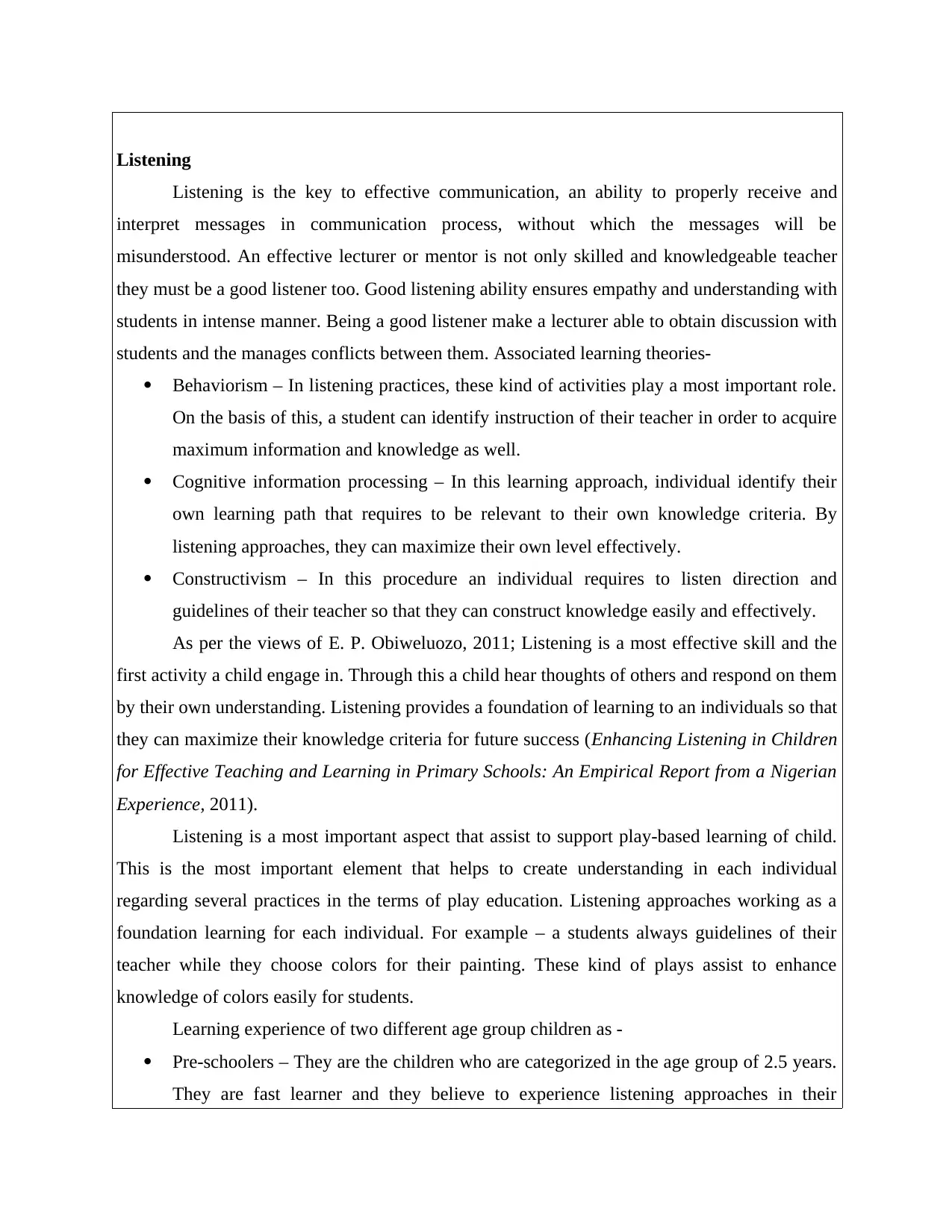
Listening
Listening is the key to effective communication, an ability to properly receive and
interpret messages in communication process, without which the messages will be
misunderstood. An effective lecturer or mentor is not only skilled and knowledgeable teacher
they must be a good listener too. Good listening ability ensures empathy and understanding with
students in intense manner. Being a good listener make a lecturer able to obtain discussion with
students and the manages conflicts between them. Associated learning theories-
Behaviorism – In listening practices, these kind of activities play a most important role.
On the basis of this, a student can identify instruction of their teacher in order to acquire
maximum information and knowledge as well.
Cognitive information processing – In this learning approach, individual identify their
own learning path that requires to be relevant to their own knowledge criteria. By
listening approaches, they can maximize their own level effectively.
Constructivism – In this procedure an individual requires to listen direction and
guidelines of their teacher so that they can construct knowledge easily and effectively.
As per the views of E. P. Obiweluozo, 2011; Listening is a most effective skill and the
first activity a child engage in. Through this a child hear thoughts of others and respond on them
by their own understanding. Listening provides a foundation of learning to an individuals so that
they can maximize their knowledge criteria for future success (Enhancing Listening in Children
for Effective Teaching and Learning in Primary Schools: An Empirical Report from a Nigerian
Experience, 2011).
Listening is a most important aspect that assist to support play-based learning of child.
This is the most important element that helps to create understanding in each individual
regarding several practices in the terms of play education. Listening approaches working as a
foundation learning for each individual. For example – a students always guidelines of their
teacher while they choose colors for their painting. These kind of plays assist to enhance
knowledge of colors easily for students.
Learning experience of two different age group children as -
Pre-schoolers – They are the children who are categorized in the age group of 2.5 years.
They are fast learner and they believe to experience listening approaches in their
Listening is the key to effective communication, an ability to properly receive and
interpret messages in communication process, without which the messages will be
misunderstood. An effective lecturer or mentor is not only skilled and knowledgeable teacher
they must be a good listener too. Good listening ability ensures empathy and understanding with
students in intense manner. Being a good listener make a lecturer able to obtain discussion with
students and the manages conflicts between them. Associated learning theories-
Behaviorism – In listening practices, these kind of activities play a most important role.
On the basis of this, a student can identify instruction of their teacher in order to acquire
maximum information and knowledge as well.
Cognitive information processing – In this learning approach, individual identify their
own learning path that requires to be relevant to their own knowledge criteria. By
listening approaches, they can maximize their own level effectively.
Constructivism – In this procedure an individual requires to listen direction and
guidelines of their teacher so that they can construct knowledge easily and effectively.
As per the views of E. P. Obiweluozo, 2011; Listening is a most effective skill and the
first activity a child engage in. Through this a child hear thoughts of others and respond on them
by their own understanding. Listening provides a foundation of learning to an individuals so that
they can maximize their knowledge criteria for future success (Enhancing Listening in Children
for Effective Teaching and Learning in Primary Schools: An Empirical Report from a Nigerian
Experience, 2011).
Listening is a most important aspect that assist to support play-based learning of child.
This is the most important element that helps to create understanding in each individual
regarding several practices in the terms of play education. Listening approaches working as a
foundation learning for each individual. For example – a students always guidelines of their
teacher while they choose colors for their painting. These kind of plays assist to enhance
knowledge of colors easily for students.
Learning experience of two different age group children as -
Pre-schoolers – They are the children who are categorized in the age group of 2.5 years.
They are fast learner and they believe to experience listening approaches in their
Paraphrase This Document
Need a fresh take? Get an instant paraphrase of this document with our AI Paraphraser
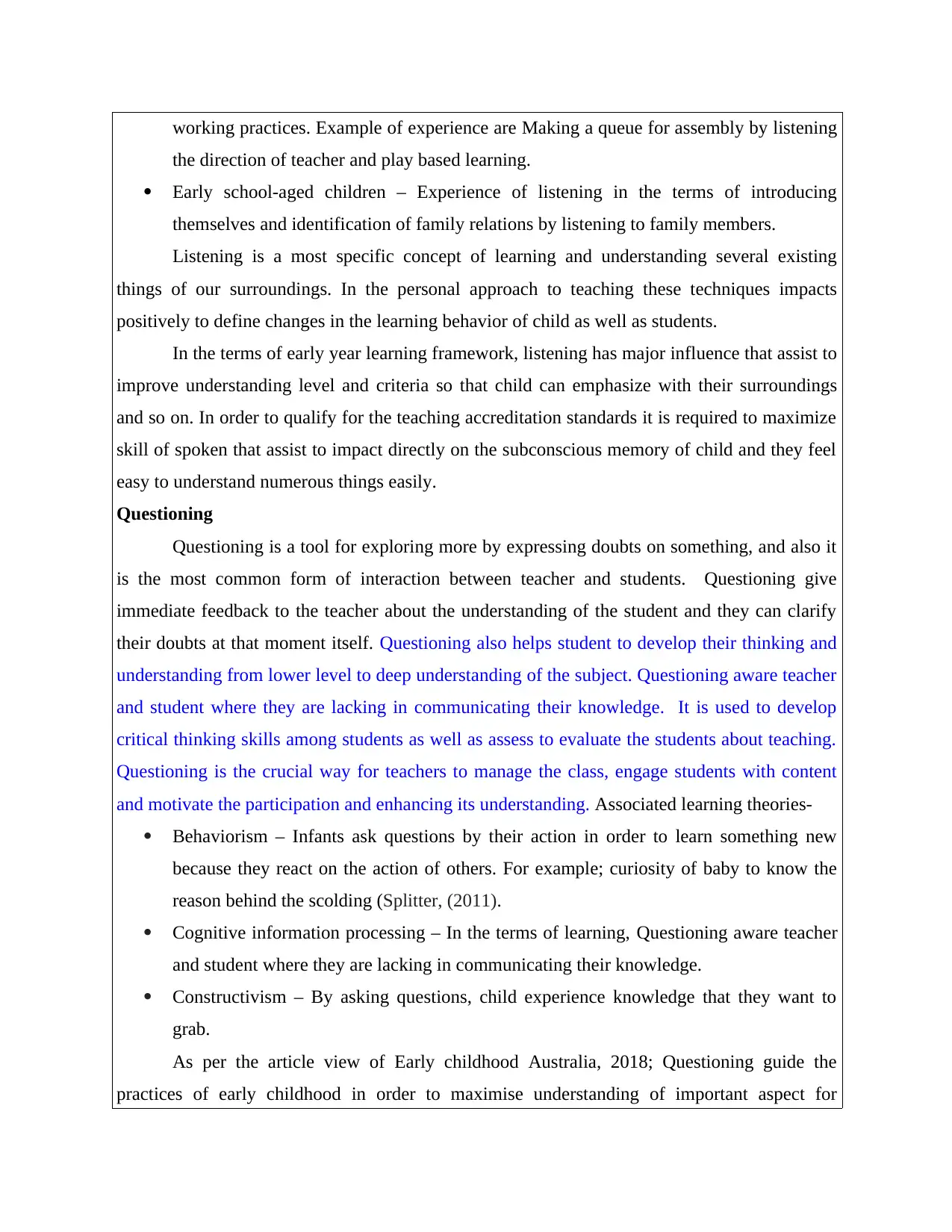
working practices. Example of experience are Making a queue for assembly by listening
the direction of teacher and play based learning.
Early school-aged children – Experience of listening in the terms of introducing
themselves and identification of family relations by listening to family members.
Listening is a most specific concept of learning and understanding several existing
things of our surroundings. In the personal approach to teaching these techniques impacts
positively to define changes in the learning behavior of child as well as students.
In the terms of early year learning framework, listening has major influence that assist to
improve understanding level and criteria so that child can emphasize with their surroundings
and so on. In order to qualify for the teaching accreditation standards it is required to maximize
skill of spoken that assist to impact directly on the subconscious memory of child and they feel
easy to understand numerous things easily.
Questioning
Questioning is a tool for exploring more by expressing doubts on something, and also it
is the most common form of interaction between teacher and students. Questioning give
immediate feedback to the teacher about the understanding of the student and they can clarify
their doubts at that moment itself. Questioning also helps student to develop their thinking and
understanding from lower level to deep understanding of the subject. Questioning aware teacher
and student where they are lacking in communicating their knowledge. It is used to develop
critical thinking skills among students as well as assess to evaluate the students about teaching.
Questioning is the crucial way for teachers to manage the class, engage students with content
and motivate the participation and enhancing its understanding. Associated learning theories-
Behaviorism – Infants ask questions by their action in order to learn something new
because they react on the action of others. For example; curiosity of baby to know the
reason behind the scolding (Splitter, (2011).
Cognitive information processing – In the terms of learning, Questioning aware teacher
and student where they are lacking in communicating their knowledge.
Constructivism – By asking questions, child experience knowledge that they want to
grab.
As per the article view of Early childhood Australia, 2018; Questioning guide the
practices of early childhood in order to maximise understanding of important aspect for
the direction of teacher and play based learning.
Early school-aged children – Experience of listening in the terms of introducing
themselves and identification of family relations by listening to family members.
Listening is a most specific concept of learning and understanding several existing
things of our surroundings. In the personal approach to teaching these techniques impacts
positively to define changes in the learning behavior of child as well as students.
In the terms of early year learning framework, listening has major influence that assist to
improve understanding level and criteria so that child can emphasize with their surroundings
and so on. In order to qualify for the teaching accreditation standards it is required to maximize
skill of spoken that assist to impact directly on the subconscious memory of child and they feel
easy to understand numerous things easily.
Questioning
Questioning is a tool for exploring more by expressing doubts on something, and also it
is the most common form of interaction between teacher and students. Questioning give
immediate feedback to the teacher about the understanding of the student and they can clarify
their doubts at that moment itself. Questioning also helps student to develop their thinking and
understanding from lower level to deep understanding of the subject. Questioning aware teacher
and student where they are lacking in communicating their knowledge. It is used to develop
critical thinking skills among students as well as assess to evaluate the students about teaching.
Questioning is the crucial way for teachers to manage the class, engage students with content
and motivate the participation and enhancing its understanding. Associated learning theories-
Behaviorism – Infants ask questions by their action in order to learn something new
because they react on the action of others. For example; curiosity of baby to know the
reason behind the scolding (Splitter, (2011).
Cognitive information processing – In the terms of learning, Questioning aware teacher
and student where they are lacking in communicating their knowledge.
Constructivism – By asking questions, child experience knowledge that they want to
grab.
As per the article view of Early childhood Australia, 2018; Questioning guide the
practices of early childhood in order to maximise understanding of important aspect for

assessing the quality of learning (Early Childhood Australia, 2018).
On the foundation level of a child, questioning assist to describe values in the terms of
play based learning. Through this, teacher needs to ask question to child in order to maximise
their learning level with implementing several activities as colour name and son on.
Learning experience of two different age group children as -
Pre-schoolers – Every child have their own way of asking question as either by doing
action like by throwing various objects in order to show his or anger.
Early school-aged children – In this age, child experience maximum curiosity by
questioning on several aspects as to identify colors name and taste of food including
vegetable as well as fruits.
In the terms of teaching, I identified numerous area of questioning by asking name of
several things to child. Through this, they experience learning by their visual and listening
approaches. These kind of activities assist to motivate students to express their ideas and
thoughts in front of others for maximizing their learning behavior. On the basis of this, teacher
build consistence level in students for the knowledge enhancement procedure.
In early year learning framework, Questioning helps student to develop their thinking
and understanding from lower level to deep understanding of the subject. Or for the Teaching
accreditation standard it is required to frame appropriate questions that assist to maximise
knowledge criteria of students (Wilson(2015).
Modelling
Modelling strategy in teaching is a effective method by which students can learn to
adopt and apply their knowledge. The process of demonstrating a concept by a teacher to
students is called modelling such like when a maths teacher models problem over the board, or
when a science teacher performs any experiment in lab for the students. Associated learning
theories-
Behaviorism – In order to make changes in the learning behavior of students, teacher
represent models and painting that impacts on the visual memories for lifelong learning.
Cognitive information processing - Modelling process with students involves giving
examples, establishing clear aims, demonstrating the process, provision of group
learning and discussions and exploring nature of both, students and teacher.
Constructivism – Modeling approach has major impact on the visual memory.
On the foundation level of a child, questioning assist to describe values in the terms of
play based learning. Through this, teacher needs to ask question to child in order to maximise
their learning level with implementing several activities as colour name and son on.
Learning experience of two different age group children as -
Pre-schoolers – Every child have their own way of asking question as either by doing
action like by throwing various objects in order to show his or anger.
Early school-aged children – In this age, child experience maximum curiosity by
questioning on several aspects as to identify colors name and taste of food including
vegetable as well as fruits.
In the terms of teaching, I identified numerous area of questioning by asking name of
several things to child. Through this, they experience learning by their visual and listening
approaches. These kind of activities assist to motivate students to express their ideas and
thoughts in front of others for maximizing their learning behavior. On the basis of this, teacher
build consistence level in students for the knowledge enhancement procedure.
In early year learning framework, Questioning helps student to develop their thinking
and understanding from lower level to deep understanding of the subject. Or for the Teaching
accreditation standard it is required to frame appropriate questions that assist to maximise
knowledge criteria of students (Wilson(2015).
Modelling
Modelling strategy in teaching is a effective method by which students can learn to
adopt and apply their knowledge. The process of demonstrating a concept by a teacher to
students is called modelling such like when a maths teacher models problem over the board, or
when a science teacher performs any experiment in lab for the students. Associated learning
theories-
Behaviorism – In order to make changes in the learning behavior of students, teacher
represent models and painting that impacts on the visual memories for lifelong learning.
Cognitive information processing - Modelling process with students involves giving
examples, establishing clear aims, demonstrating the process, provision of group
learning and discussions and exploring nature of both, students and teacher.
Constructivism – Modeling approach has major impact on the visual memory.
⊘ This is a preview!⊘
Do you want full access?
Subscribe today to unlock all pages.

Trusted by 1+ million students worldwide
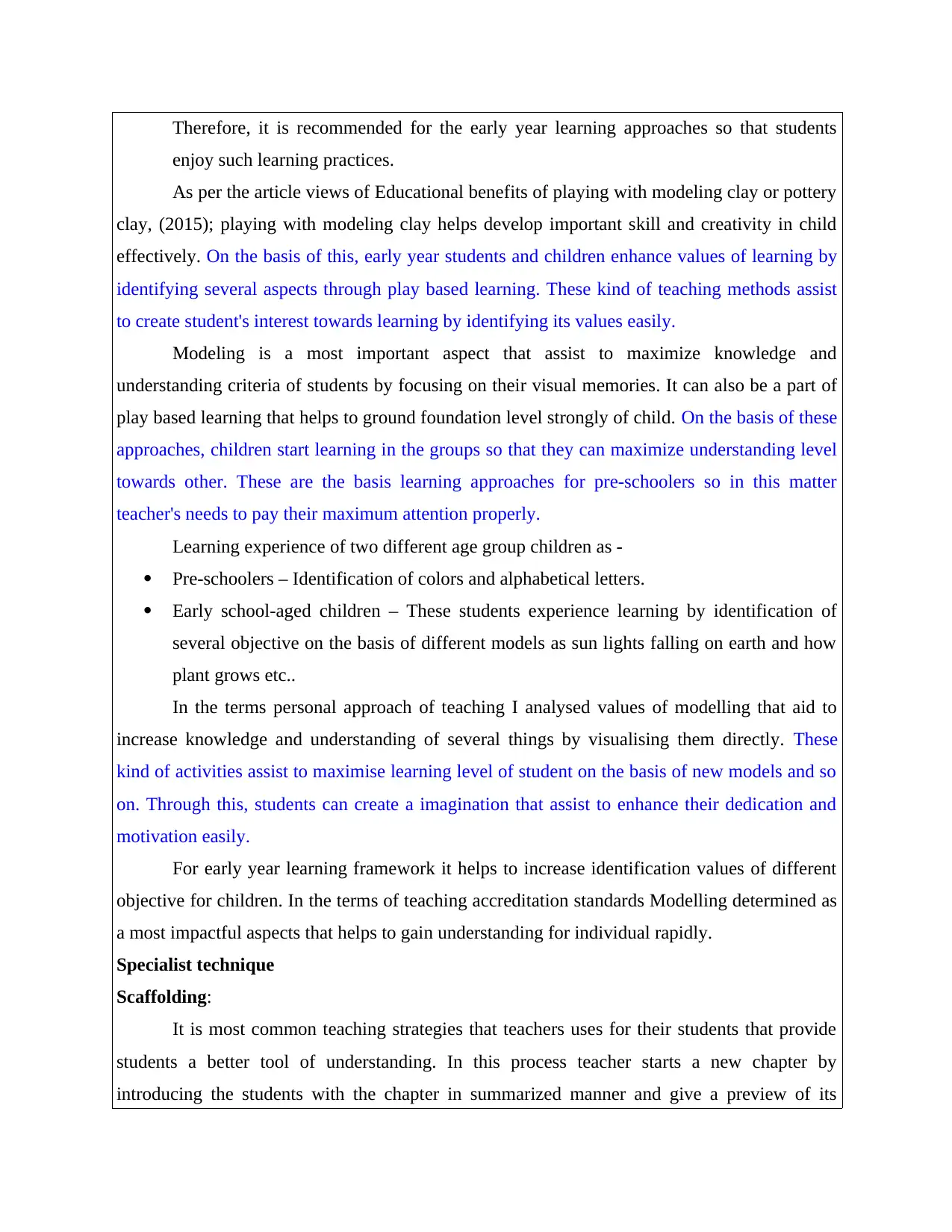
Therefore, it is recommended for the early year learning approaches so that students
enjoy such learning practices.
As per the article views of Educational benefits of playing with modeling clay or pottery
clay, (2015); playing with modeling clay helps develop important skill and creativity in child
effectively. On the basis of this, early year students and children enhance values of learning by
identifying several aspects through play based learning. These kind of teaching methods assist
to create student's interest towards learning by identifying its values easily.
Modeling is a most important aspect that assist to maximize knowledge and
understanding criteria of students by focusing on their visual memories. It can also be a part of
play based learning that helps to ground foundation level strongly of child. On the basis of these
approaches, children start learning in the groups so that they can maximize understanding level
towards other. These are the basis learning approaches for pre-schoolers so in this matter
teacher's needs to pay their maximum attention properly.
Learning experience of two different age group children as -
Pre-schoolers – Identification of colors and alphabetical letters.
Early school-aged children – These students experience learning by identification of
several objective on the basis of different models as sun lights falling on earth and how
plant grows etc..
In the terms personal approach of teaching I analysed values of modelling that aid to
increase knowledge and understanding of several things by visualising them directly. These
kind of activities assist to maximise learning level of student on the basis of new models and so
on. Through this, students can create a imagination that assist to enhance their dedication and
motivation easily.
For early year learning framework it helps to increase identification values of different
objective for children. In the terms of teaching accreditation standards Modelling determined as
a most impactful aspects that helps to gain understanding for individual rapidly.
Specialist technique
Scaffolding:
It is most common teaching strategies that teachers uses for their students that provide
students a better tool of understanding. In this process teacher starts a new chapter by
introducing the students with the chapter in summarized manner and give a preview of its
enjoy such learning practices.
As per the article views of Educational benefits of playing with modeling clay or pottery
clay, (2015); playing with modeling clay helps develop important skill and creativity in child
effectively. On the basis of this, early year students and children enhance values of learning by
identifying several aspects through play based learning. These kind of teaching methods assist
to create student's interest towards learning by identifying its values easily.
Modeling is a most important aspect that assist to maximize knowledge and
understanding criteria of students by focusing on their visual memories. It can also be a part of
play based learning that helps to ground foundation level strongly of child. On the basis of these
approaches, children start learning in the groups so that they can maximize understanding level
towards other. These are the basis learning approaches for pre-schoolers so in this matter
teacher's needs to pay their maximum attention properly.
Learning experience of two different age group children as -
Pre-schoolers – Identification of colors and alphabetical letters.
Early school-aged children – These students experience learning by identification of
several objective on the basis of different models as sun lights falling on earth and how
plant grows etc..
In the terms personal approach of teaching I analysed values of modelling that aid to
increase knowledge and understanding of several things by visualising them directly. These
kind of activities assist to maximise learning level of student on the basis of new models and so
on. Through this, students can create a imagination that assist to enhance their dedication and
motivation easily.
For early year learning framework it helps to increase identification values of different
objective for children. In the terms of teaching accreditation standards Modelling determined as
a most impactful aspects that helps to gain understanding for individual rapidly.
Specialist technique
Scaffolding:
It is most common teaching strategies that teachers uses for their students that provide
students a better tool of understanding. In this process teacher starts a new chapter by
introducing the students with the chapter in summarized manner and give a preview of its
Paraphrase This Document
Need a fresh take? Get an instant paraphrase of this document with our AI Paraphraser
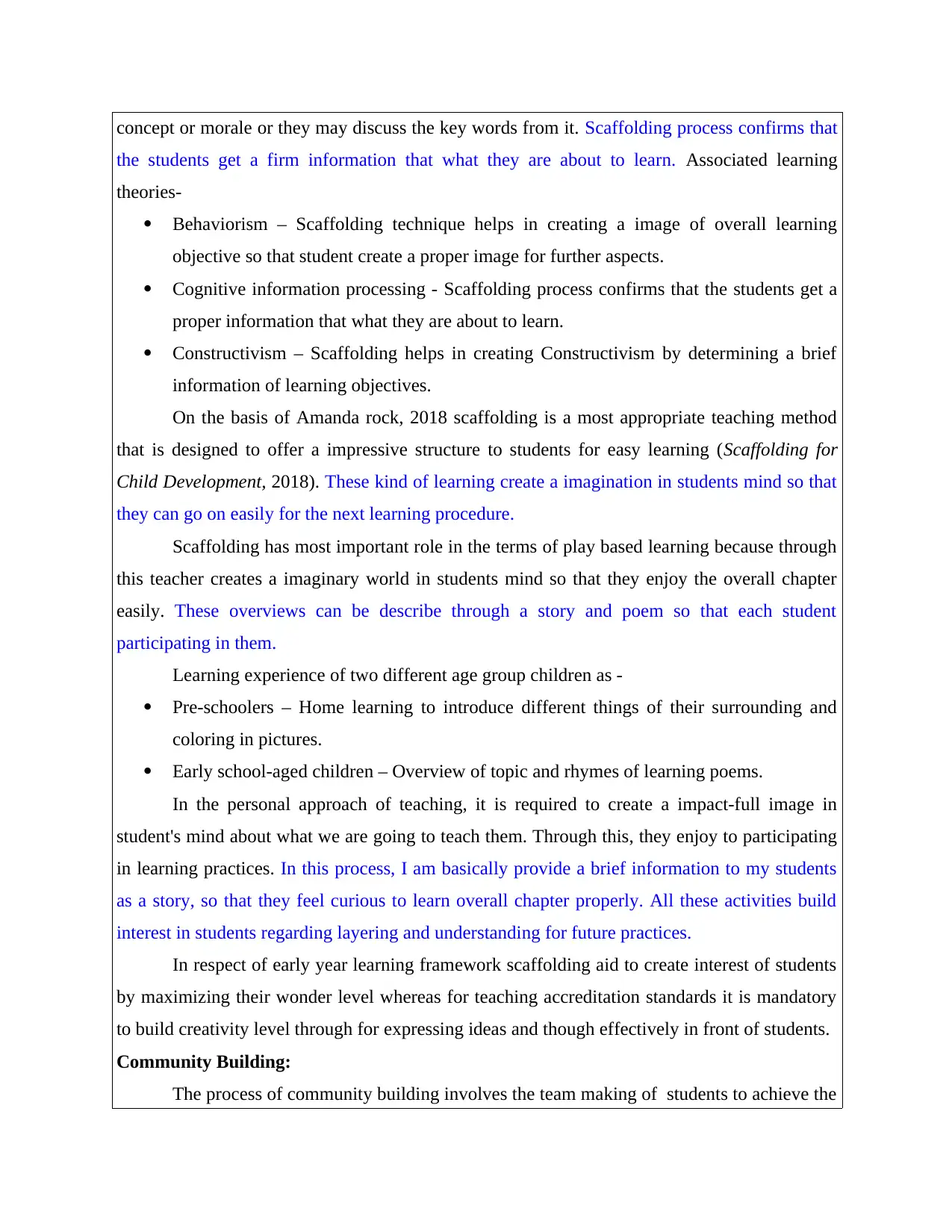
concept or morale or they may discuss the key words from it. Scaffolding process confirms that
the students get a firm information that what they are about to learn. Associated learning
theories-
Behaviorism – Scaffolding technique helps in creating a image of overall learning
objective so that student create a proper image for further aspects.
Cognitive information processing - Scaffolding process confirms that the students get a
proper information that what they are about to learn.
Constructivism – Scaffolding helps in creating Constructivism by determining a brief
information of learning objectives.
On the basis of Amanda rock, 2018 scaffolding is a most appropriate teaching method
that is designed to offer a impressive structure to students for easy learning (Scaffolding for
Child Development, 2018). These kind of learning create a imagination in students mind so that
they can go on easily for the next learning procedure.
Scaffolding has most important role in the terms of play based learning because through
this teacher creates a imaginary world in students mind so that they enjoy the overall chapter
easily. These overviews can be describe through a story and poem so that each student
participating in them.
Learning experience of two different age group children as -
Pre-schoolers – Home learning to introduce different things of their surrounding and
coloring in pictures.
Early school-aged children – Overview of topic and rhymes of learning poems.
In the personal approach of teaching, it is required to create a impact-full image in
student's mind about what we are going to teach them. Through this, they enjoy to participating
in learning practices. In this process, I am basically provide a brief information to my students
as a story, so that they feel curious to learn overall chapter properly. All these activities build
interest in students regarding layering and understanding for future practices.
In respect of early year learning framework scaffolding aid to create interest of students
by maximizing their wonder level whereas for teaching accreditation standards it is mandatory
to build creativity level through for expressing ideas and though effectively in front of students.
Community Building:
The process of community building involves the team making of students to achieve the
the students get a firm information that what they are about to learn. Associated learning
theories-
Behaviorism – Scaffolding technique helps in creating a image of overall learning
objective so that student create a proper image for further aspects.
Cognitive information processing - Scaffolding process confirms that the students get a
proper information that what they are about to learn.
Constructivism – Scaffolding helps in creating Constructivism by determining a brief
information of learning objectives.
On the basis of Amanda rock, 2018 scaffolding is a most appropriate teaching method
that is designed to offer a impressive structure to students for easy learning (Scaffolding for
Child Development, 2018). These kind of learning create a imagination in students mind so that
they can go on easily for the next learning procedure.
Scaffolding has most important role in the terms of play based learning because through
this teacher creates a imaginary world in students mind so that they enjoy the overall chapter
easily. These overviews can be describe through a story and poem so that each student
participating in them.
Learning experience of two different age group children as -
Pre-schoolers – Home learning to introduce different things of their surrounding and
coloring in pictures.
Early school-aged children – Overview of topic and rhymes of learning poems.
In the personal approach of teaching, it is required to create a impact-full image in
student's mind about what we are going to teach them. Through this, they enjoy to participating
in learning practices. In this process, I am basically provide a brief information to my students
as a story, so that they feel curious to learn overall chapter properly. All these activities build
interest in students regarding layering and understanding for future practices.
In respect of early year learning framework scaffolding aid to create interest of students
by maximizing their wonder level whereas for teaching accreditation standards it is mandatory
to build creativity level through for expressing ideas and though effectively in front of students.
Community Building:
The process of community building involves the team making of students to achieve the
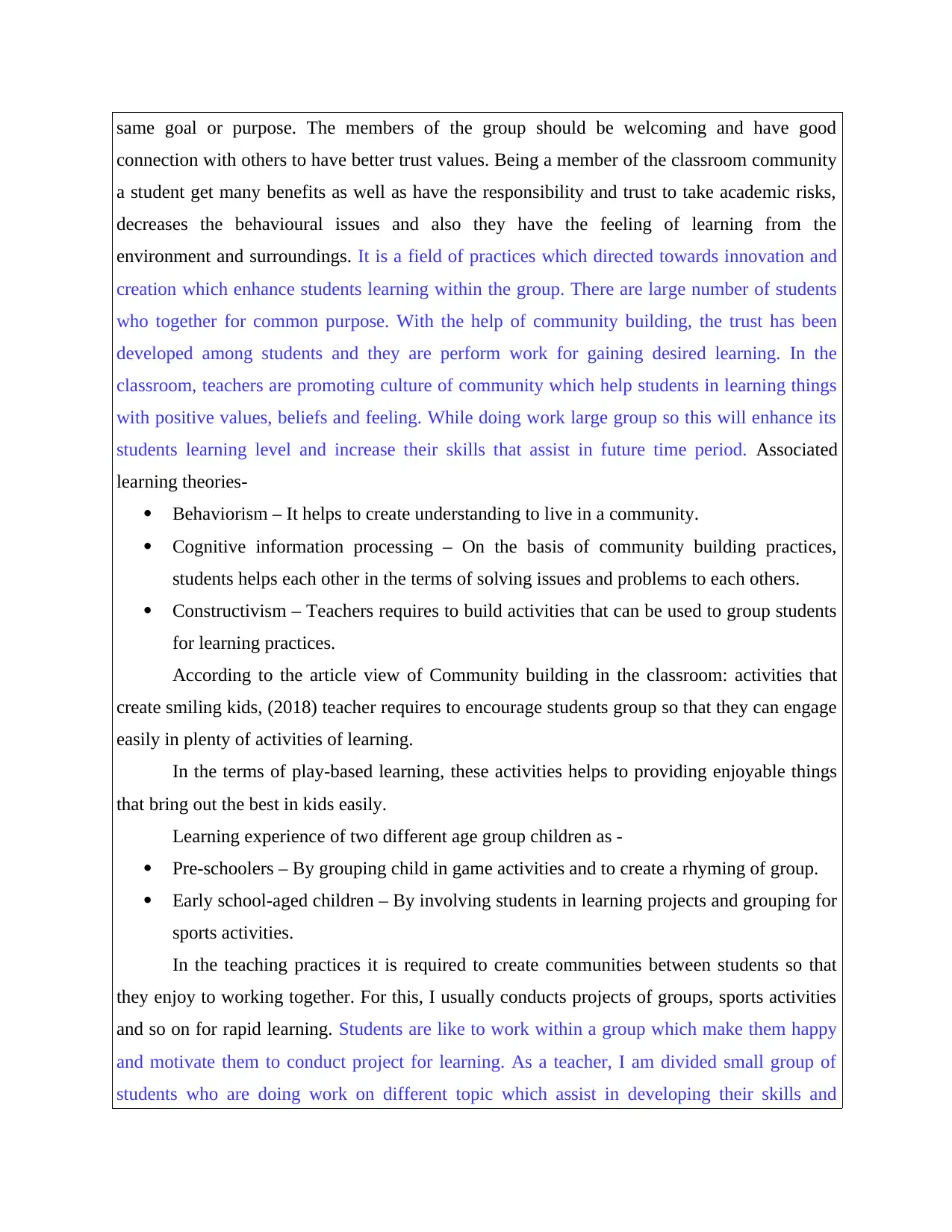
same goal or purpose. The members of the group should be welcoming and have good
connection with others to have better trust values. Being a member of the classroom community
a student get many benefits as well as have the responsibility and trust to take academic risks,
decreases the behavioural issues and also they have the feeling of learning from the
environment and surroundings. It is a field of practices which directed towards innovation and
creation which enhance students learning within the group. There are large number of students
who together for common purpose. With the help of community building, the trust has been
developed among students and they are perform work for gaining desired learning. In the
classroom, teachers are promoting culture of community which help students in learning things
with positive values, beliefs and feeling. While doing work large group so this will enhance its
students learning level and increase their skills that assist in future time period. Associated
learning theories-
Behaviorism – It helps to create understanding to live in a community.
Cognitive information processing – On the basis of community building practices,
students helps each other in the terms of solving issues and problems to each others.
Constructivism – Teachers requires to build activities that can be used to group students
for learning practices.
According to the article view of Community building in the classroom: activities that
create smiling kids, (2018) teacher requires to encourage students group so that they can engage
easily in plenty of activities of learning.
In the terms of play-based learning, these activities helps to providing enjoyable things
that bring out the best in kids easily.
Learning experience of two different age group children as -
Pre-schoolers – By grouping child in game activities and to create a rhyming of group.
Early school-aged children – By involving students in learning projects and grouping for
sports activities.
In the teaching practices it is required to create communities between students so that
they enjoy to working together. For this, I usually conducts projects of groups, sports activities
and so on for rapid learning. Students are like to work within a group which make them happy
and motivate them to conduct project for learning. As a teacher, I am divided small group of
students who are doing work on different topic which assist in developing their skills and
connection with others to have better trust values. Being a member of the classroom community
a student get many benefits as well as have the responsibility and trust to take academic risks,
decreases the behavioural issues and also they have the feeling of learning from the
environment and surroundings. It is a field of practices which directed towards innovation and
creation which enhance students learning within the group. There are large number of students
who together for common purpose. With the help of community building, the trust has been
developed among students and they are perform work for gaining desired learning. In the
classroom, teachers are promoting culture of community which help students in learning things
with positive values, beliefs and feeling. While doing work large group so this will enhance its
students learning level and increase their skills that assist in future time period. Associated
learning theories-
Behaviorism – It helps to create understanding to live in a community.
Cognitive information processing – On the basis of community building practices,
students helps each other in the terms of solving issues and problems to each others.
Constructivism – Teachers requires to build activities that can be used to group students
for learning practices.
According to the article view of Community building in the classroom: activities that
create smiling kids, (2018) teacher requires to encourage students group so that they can engage
easily in plenty of activities of learning.
In the terms of play-based learning, these activities helps to providing enjoyable things
that bring out the best in kids easily.
Learning experience of two different age group children as -
Pre-schoolers – By grouping child in game activities and to create a rhyming of group.
Early school-aged children – By involving students in learning projects and grouping for
sports activities.
In the teaching practices it is required to create communities between students so that
they enjoy to working together. For this, I usually conducts projects of groups, sports activities
and so on for rapid learning. Students are like to work within a group which make them happy
and motivate them to conduct project for learning. As a teacher, I am divided small group of
students who are doing work on different topic which assist in developing their skills and
⊘ This is a preview!⊘
Do you want full access?
Subscribe today to unlock all pages.

Trusted by 1+ million students worldwide

knowledge.
In the terms of early year learning framework community building aid to create positive
behavior of students toward other. On the other hand for teaching accreditation standards it is
required to identify several practices for grouping approaches.
Reinforcing:
It is the way to strengthen the students by increasing their motivation level and
supporting them for their work in a positive manner. The commonly used methods of
reinforcing the students is by praising them in the classroom for their performance or work. It
involves doing something and providing some thing to students which enhance the likelihood in
which skill or behaviour will be repeated. It is essential element in teaching new abilities. With
the help of reinforcing, they provide students feedback on the basis of their performance and
enhance its desired strength and eliminate its undesired performance. It is used for reinforce the
learning or behaviour which may find out most effective relation. In this, the students mainly
focus on gaining motivation factor which help them in increasing its performance level. The
teacher provide reward and award when some student perform good and proper work in the
class room. Through this, they are generating ideas and opinions which are best suitable for
their working condition. Associated learning theories -
Behaviorism – On the basis of these leanings, students feel motivated toward their new
objectives. In this, students are mainly focus on objectively observable behaviors in
order to motivate themselves.
Cognitive information processing – it define approaches by giving another opportunity
to students to perform more better or by giving them extra attention (Arthur, (2018).
Constructivism – Teacher create a educational framework for reinforcement of students.
Learning experience of two different age group children as -
Pre-schoolers – By setting goals of clay activities and toy activities as well.
Early school-aged children – By denoting specific goal in sports activities and
experimenting realistic things.
In the terms of reinforcing, I usually encourage students that assist to make them feel
motivated. Through this, teachers encourage student to perform better on the basis of their
abilities and skills. I am able to motivate students through which they can perform better in the
class room and try to complete all work in given period. As a teacher, I am developing good and
In the terms of early year learning framework community building aid to create positive
behavior of students toward other. On the other hand for teaching accreditation standards it is
required to identify several practices for grouping approaches.
Reinforcing:
It is the way to strengthen the students by increasing their motivation level and
supporting them for their work in a positive manner. The commonly used methods of
reinforcing the students is by praising them in the classroom for their performance or work. It
involves doing something and providing some thing to students which enhance the likelihood in
which skill or behaviour will be repeated. It is essential element in teaching new abilities. With
the help of reinforcing, they provide students feedback on the basis of their performance and
enhance its desired strength and eliminate its undesired performance. It is used for reinforce the
learning or behaviour which may find out most effective relation. In this, the students mainly
focus on gaining motivation factor which help them in increasing its performance level. The
teacher provide reward and award when some student perform good and proper work in the
class room. Through this, they are generating ideas and opinions which are best suitable for
their working condition. Associated learning theories -
Behaviorism – On the basis of these leanings, students feel motivated toward their new
objectives. In this, students are mainly focus on objectively observable behaviors in
order to motivate themselves.
Cognitive information processing – it define approaches by giving another opportunity
to students to perform more better or by giving them extra attention (Arthur, (2018).
Constructivism – Teacher create a educational framework for reinforcement of students.
Learning experience of two different age group children as -
Pre-schoolers – By setting goals of clay activities and toy activities as well.
Early school-aged children – By denoting specific goal in sports activities and
experimenting realistic things.
In the terms of reinforcing, I usually encourage students that assist to make them feel
motivated. Through this, teachers encourage student to perform better on the basis of their
abilities and skills. I am able to motivate students through which they can perform better in the
class room and try to complete all work in given period. As a teacher, I am developing good and
Paraphrase This Document
Need a fresh take? Get an instant paraphrase of this document with our AI Paraphraser
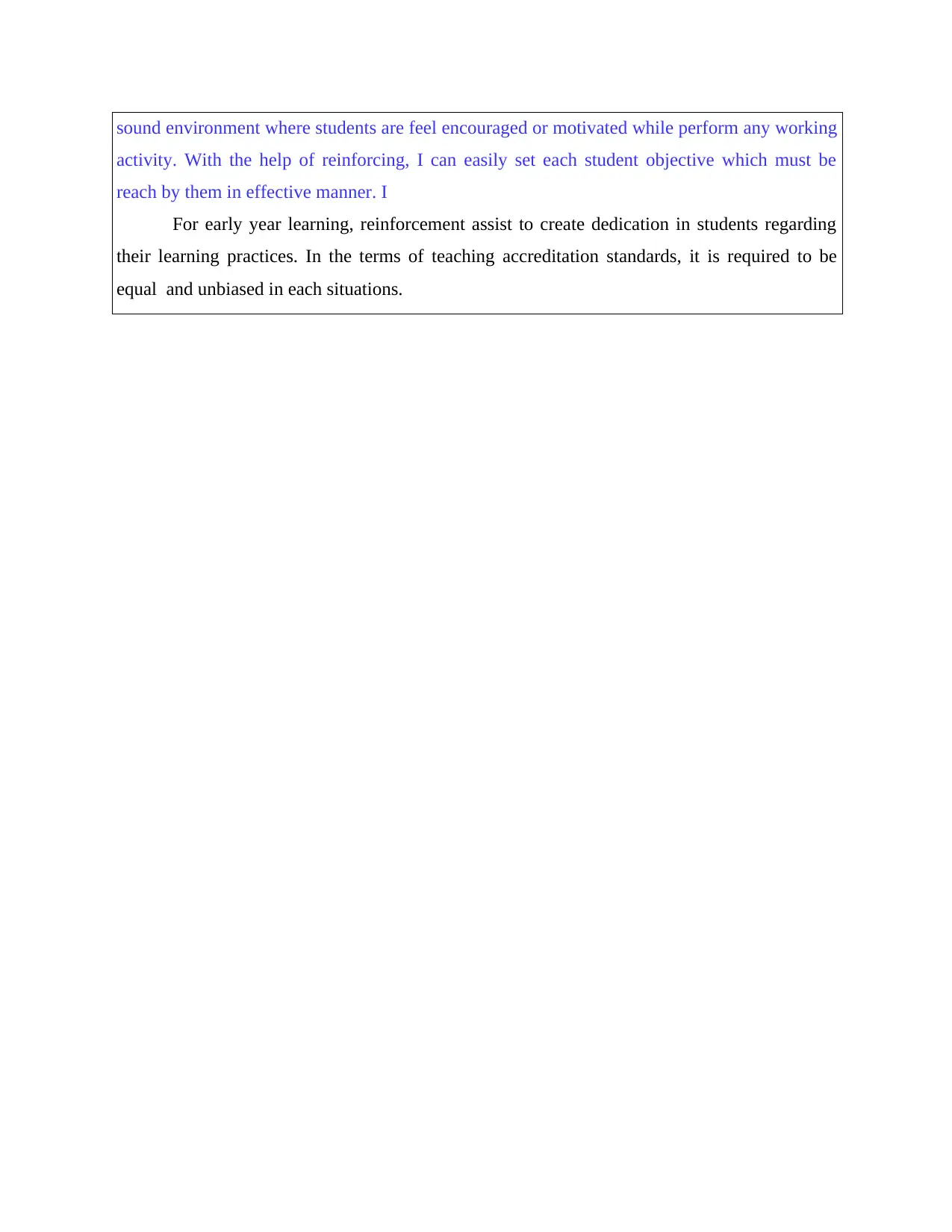
sound environment where students are feel encouraged or motivated while perform any working
activity. With the help of reinforcing, I can easily set each student objective which must be
reach by them in effective manner. I
For early year learning, reinforcement assist to create dedication in students regarding
their learning practices. In the terms of teaching accreditation standards, it is required to be
equal and unbiased in each situations.
activity. With the help of reinforcing, I can easily set each student objective which must be
reach by them in effective manner. I
For early year learning, reinforcement assist to create dedication in students regarding
their learning practices. In the terms of teaching accreditation standards, it is required to be
equal and unbiased in each situations.
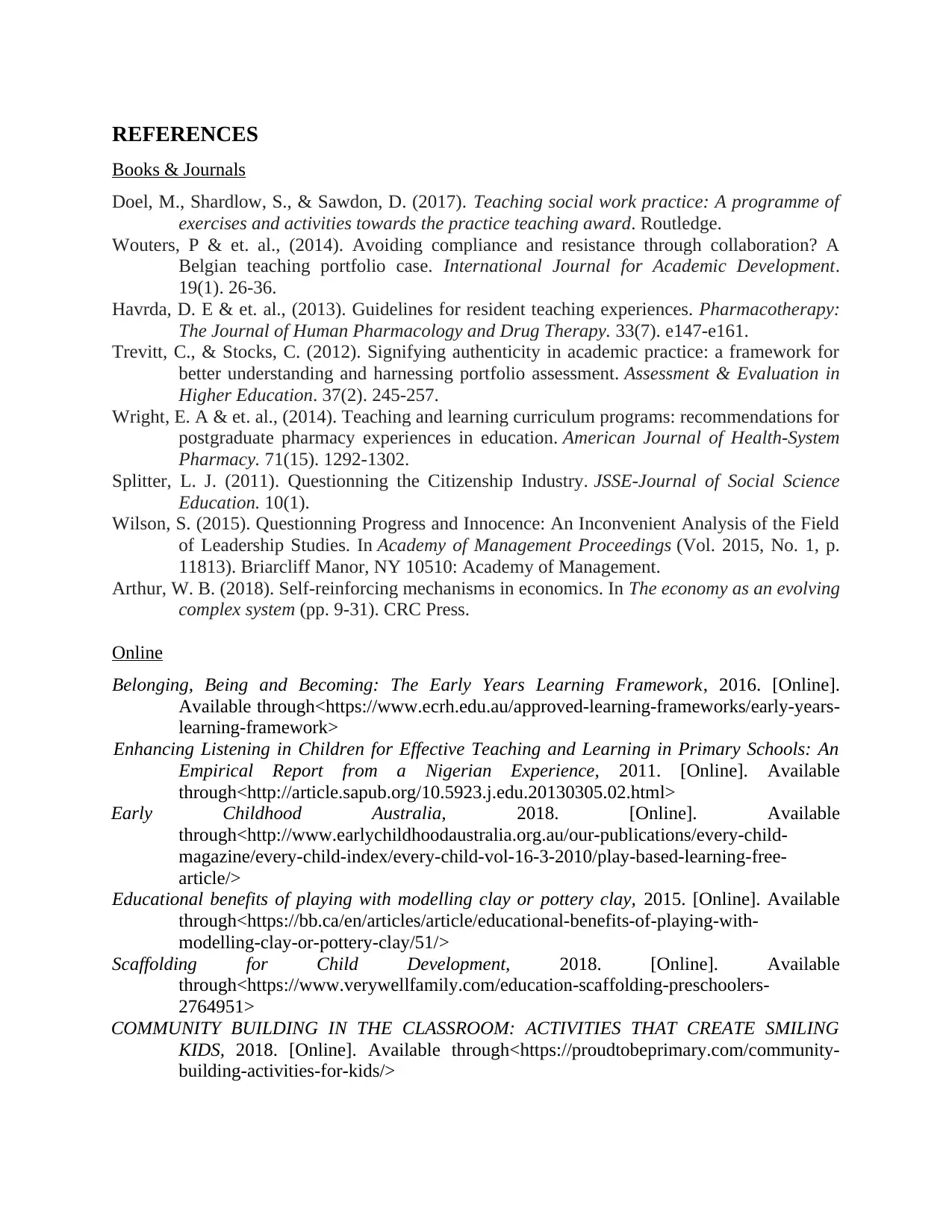
REFERENCES
Books & Journals
Doel, M., Shardlow, S., & Sawdon, D. (2017). Teaching social work practice: A programme of
exercises and activities towards the practice teaching award. Routledge.
Wouters, P & et. al., (2014). Avoiding compliance and resistance through collaboration? A
Belgian teaching portfolio case. International Journal for Academic Development.
19(1). 26-36.
Havrda, D. E & et. al., (2013). Guidelines for resident teaching experiences. Pharmacotherapy:
The Journal of Human Pharmacology and Drug Therapy. 33(7). e147-e161.
Trevitt, C., & Stocks, C. (2012). Signifying authenticity in academic practice: a framework for
better understanding and harnessing portfolio assessment. Assessment & Evaluation in
Higher Education. 37(2). 245-257.
Wright, E. A & et. al., (2014). Teaching and learning curriculum programs: recommendations for
postgraduate pharmacy experiences in education. American Journal of Health-System
Pharmacy. 71(15). 1292-1302.
Splitter, L. J. (2011). Questionning the Citizenship Industry. JSSE-Journal of Social Science
Education. 10(1).
Wilson, S. (2015). Questionning Progress and Innocence: An Inconvenient Analysis of the Field
of Leadership Studies. In Academy of Management Proceedings (Vol. 2015, No. 1, p.
11813). Briarcliff Manor, NY 10510: Academy of Management.
Arthur, W. B. (2018). Self-reinforcing mechanisms in economics. In The economy as an evolving
complex system (pp. 9-31). CRC Press.
Online
Belonging, Being and Becoming: The Early Years Learning Framework, 2016. [Online].
Available through<https://www.ecrh.edu.au/approved-learning-frameworks/early-years-
learning-framework>
Enhancing Listening in Children for Effective Teaching and Learning in Primary Schools: An
Empirical Report from a Nigerian Experience, 2011. [Online]. Available
through<http://article.sapub.org/10.5923.j.edu.20130305.02.html>
Early Childhood Australia, 2018. [Online]. Available
through<http://www.earlychildhoodaustralia.org.au/our-publications/every-child-
magazine/every-child-index/every-child-vol-16-3-2010/play-based-learning-free-
article/>
Educational benefits of playing with modelling clay or pottery clay, 2015. [Online]. Available
through<https://bb.ca/en/articles/article/educational-benefits-of-playing-with-
modelling-clay-or-pottery-clay/51/>
Scaffolding for Child Development, 2018. [Online]. Available
through<https://www.verywellfamily.com/education-scaffolding-preschoolers-
2764951>
COMMUNITY BUILDING IN THE CLASSROOM: ACTIVITIES THAT CREATE SMILING
KIDS, 2018. [Online]. Available through<https://proudtobeprimary.com/community-
building-activities-for-kids/>
Books & Journals
Doel, M., Shardlow, S., & Sawdon, D. (2017). Teaching social work practice: A programme of
exercises and activities towards the practice teaching award. Routledge.
Wouters, P & et. al., (2014). Avoiding compliance and resistance through collaboration? A
Belgian teaching portfolio case. International Journal for Academic Development.
19(1). 26-36.
Havrda, D. E & et. al., (2013). Guidelines for resident teaching experiences. Pharmacotherapy:
The Journal of Human Pharmacology and Drug Therapy. 33(7). e147-e161.
Trevitt, C., & Stocks, C. (2012). Signifying authenticity in academic practice: a framework for
better understanding and harnessing portfolio assessment. Assessment & Evaluation in
Higher Education. 37(2). 245-257.
Wright, E. A & et. al., (2014). Teaching and learning curriculum programs: recommendations for
postgraduate pharmacy experiences in education. American Journal of Health-System
Pharmacy. 71(15). 1292-1302.
Splitter, L. J. (2011). Questionning the Citizenship Industry. JSSE-Journal of Social Science
Education. 10(1).
Wilson, S. (2015). Questionning Progress and Innocence: An Inconvenient Analysis of the Field
of Leadership Studies. In Academy of Management Proceedings (Vol. 2015, No. 1, p.
11813). Briarcliff Manor, NY 10510: Academy of Management.
Arthur, W. B. (2018). Self-reinforcing mechanisms in economics. In The economy as an evolving
complex system (pp. 9-31). CRC Press.
Online
Belonging, Being and Becoming: The Early Years Learning Framework, 2016. [Online].
Available through<https://www.ecrh.edu.au/approved-learning-frameworks/early-years-
learning-framework>
Enhancing Listening in Children for Effective Teaching and Learning in Primary Schools: An
Empirical Report from a Nigerian Experience, 2011. [Online]. Available
through<http://article.sapub.org/10.5923.j.edu.20130305.02.html>
Early Childhood Australia, 2018. [Online]. Available
through<http://www.earlychildhoodaustralia.org.au/our-publications/every-child-
magazine/every-child-index/every-child-vol-16-3-2010/play-based-learning-free-
article/>
Educational benefits of playing with modelling clay or pottery clay, 2015. [Online]. Available
through<https://bb.ca/en/articles/article/educational-benefits-of-playing-with-
modelling-clay-or-pottery-clay/51/>
Scaffolding for Child Development, 2018. [Online]. Available
through<https://www.verywellfamily.com/education-scaffolding-preschoolers-
2764951>
COMMUNITY BUILDING IN THE CLASSROOM: ACTIVITIES THAT CREATE SMILING
KIDS, 2018. [Online]. Available through<https://proudtobeprimary.com/community-
building-activities-for-kids/>
⊘ This is a preview!⊘
Do you want full access?
Subscribe today to unlock all pages.

Trusted by 1+ million students worldwide
1 out of 12
Related Documents
Your All-in-One AI-Powered Toolkit for Academic Success.
+13062052269
info@desklib.com
Available 24*7 on WhatsApp / Email
![[object Object]](/_next/static/media/star-bottom.7253800d.svg)
Unlock your academic potential
Copyright © 2020–2025 A2Z Services. All Rights Reserved. Developed and managed by ZUCOL.





